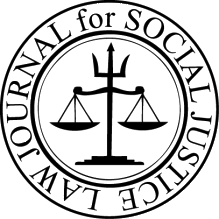Volume IX, Spring 2018 Law Journal for Social Justice
The 2018 Law Journal for Social Justice Symposium, “Activism and the Law,” explored both the proper role and potential of the law to be a tool for activism whether wielded by legal professionals or laypeople. The symposium opened with keynote speaker Tempe Councilmember Lauren Kuby discussing her life in advocacy, and progressed to explore the perspectives of lawyers and non-legal activists in two panels moderated by Professor Howard Cabot and Associate Dean Zachary Kramer. Panelists included Julie Gunnigle, solo-practitioner in Midwifery and Birth Law; Jon Ruybalid Of Counsel, Gammon & Grange and Assistant Professor, GCU; Camellia Bellis, Education and Training Specialist, Office of Diversity and Inclusion, University of Arizona College of Medicine; and Jessalynne Howard, Volunteer Coordinator, International Rescue Committee. Special thanks to our Symposium Editor, Katherine Montgomery, for her hard work in organizing and orchestrating this amazing event.
This volume of the Law Journal for Social Justice concludes a very special year for us. As previously mentioned in our Fall 2017 volume, we began this year striving to publish twice in one year for the first time in our journal’s history. With the publication of this Spring 2018 volume, we have achieved that goal and have thus brought another successful academic year to a close. Special thanks to our staff who methodically and commendably handled double the workload and led us to the completion of our goal. With the dedication of our staff, we were able to bring even more quality social justice legal scholarship to the public, and as such, further our mission.
This issue begins with an examination of how local over-incarceration can be addressed and remedied in Fixing Arizona’s Mass Incarceration Dilemma. Next, Chance Meyer reflects on the ways in which the President’s explicit views can affect public opinion in Death Penalty “Trump Effect”. Amy Albert examines how a current deficiency in understanding animal hoarders harms policy in Animal Hoarding: A Response to HARC. Brittany S. Brown reflects on the ways in which U.S. prisons fail to adequately diagnose and treat the mentally ill, to the detriment of public health in The Epidemic of Mental Illness in America’s “New Asylums”. This issue concludes with two of LJSJ’s own. Michael Gorelik argues for a more critical perspective of the ways criminal courts use and defer to technology in Descending bxack into Plato’s Cave: The Use of Artificial Intelligence in Criminal Sentencing. Finally, Danielle Ser explains How to Combat High Animal Shelter Dog Euthanasia Rates in Maricopa County, Arizona.
John A. Burnett
2017-2018 Editor-in-Chief
Law Journal for Social Justice
